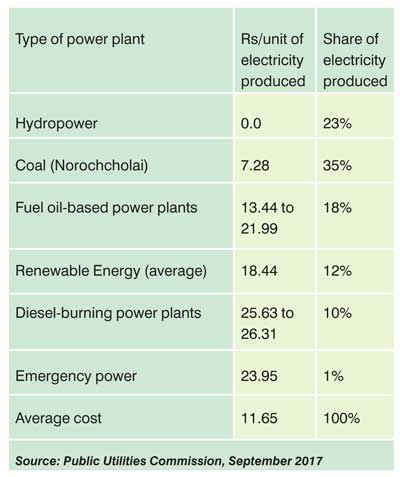Thursday Dec 04, 2025
Thursday Dec 04, 2025
Tuesday, 10 October 2017 00:01 - - {{hitsCtrl.values.hits}}
The above was precisely the heading of a newspaper article in November 2001. I repeat the first three sentences:
As it has always been, the present power crisis and the (upcoming) price increases will be blamed on the weather and the increase in international oil prices. The weather gods, unable to defend themselves, will silently take the blame. Dry weather is not the cause for the crisis. High(er) oil prices are not the reason for the (upcoming) price increases.
Now, 16 years later, the Minister of Power and Renewable Energy sought Cabinet approval to buy diesel engines to produce 100 Megawatt electricity, exactly as it was done in 1996, 1999 to 2001, and more recently in 2016. Additionally, 60 Megawatt of similar diesel power plants are already operational.
Yet more, a further 170 Megawatt of oil power plants retired have been recalled. Furthermore, all the oil power plants in the country are operating on full power for the past several months. So, 170+60+100 = 330 MW; we have only 170MW more to get to 500 Megawatt Sampur power plant, the President and the Prime Minister cancelled in 2015.
So, in a few months, another contract can be given for 170 Megawatt, and then the replacement of Sampur with diesel power plants would be complete. See how beautifully and skilfully the professional view is overtaken by business interests, and see how precisely the numbers add up.
To do what? To produce electricity at three times the cost! Look at the table. It is not my data, but the data from PUCSL, stamped, sealed and approved by the guardian of the electricity sector, and its customers.
The fundamental reason for the power crises that come up every now and then, is the non-implementation of power plant projects on schedule. Instead of pushing CEB to build the correct types of power plants at the correct time, governments at all times have tried to dilute the responsibility, appoint committees to build power plants (which obviously cannot build power plants), and when the crisis finally arrives, run away, leaving the Energy Minister to take the blame.
Why are people so interested to build power plants, cancel power plants, not build power plants, call for bids and not build power plants? The common man thinks it is the love for the environment, that causes such actions. Then when the Energy Minister tells Cabinet that he wants to purchase emergency (diesel) power, why do we not hear of any protests? Why isn’t the President asking Prime Minister Modi to “convert” the very polluting diesel power plant to operate on (non-existent) gas? Oh why? Tell us. Oh why?
Production costs
The Public Utilities Commission of Sri Lanka (PUCSL), the watchdog presumed to be looking after customer interests, has published the approved production costs, as seen in the table, for March-September 2017. For simplicity, we summarise the cost table by dividing into six categories (see table).
It is true that hydropower is lower in 2016 and 2017, compared with 2015, or the historic average. However, that need not be a new discovery; in living memory, hydropower was below average in years 1979, 1983, 1987, 1992, 1996, 2000-1, 2004-5, 2009, 2012 and 2014.
To overcome such shortages, without placing the country and its electricity customers in jeopardy, the planning engineers prepare a 20-year forward plan, and update it once in two years. The update considers not only the additional information on hydrology and rainfall, but the changing costs of options available to produce electricity, and their technical strengths and limitations, renewables included.
Target of the plan: Produce electricity
at the lowest possible cost
Politicians and many others do not like this plan, largely because, the types of power plants supplied by their favoured suppliers are not in the proposed power plants in CEB’s list. So, they meddle with the plan, to the extent that people in the country and investors think that the country has no plan to develop power generation.
The meddling happens as follows: The Government appoints committee after committee to review the CEB plan, until some committee says CEB plan is not good, but the President’s and Prime Minister’s plan is good: in the recent past there were two committees and one individual appointed; only one person in one of the two committees and the expatriate individual had the insight and experience of what a power system is and how it operates, and more importantly, the importance of sticking to a plan, and the dangers of abrupt changes. Others toed the political line. The regulatory commission, the PUCSL, endorsed the abrupt change wholeheartedly.
The meddling with the plan also happens as follows: a standing committee is appointed under another Ministry, such as the Ministry of Finance or even the Ministry of International Trade (it does not matter) in the guise of expediting the implementation. The Ministry of Energy becomes an observer in this committee.
CEB planners are repeatedly asked to come to meetings, their professional reports are tossed in the air, sometimes by the highest in the land and more frequently by minions sitting in these committees, and pressed to change the plan. CEB refuses, but the PUCSL, the regulatory commission, agrees to get the job done. Meaning to sanitise the ad-hoc decisions wanted by politicians. A good three years would be lost in this wrangling.
Right now, Sri Lanka is at this point of this game called “playing ball with power plants”, a new game invented and played only in Sri Lanka. Not new. Played since 1993, precisely by the same people who are playing the game now.
Note that the President and the Prime Minister do not appoint such committees outside the respective Ministry for subjects such as social welfare or health, national heritage or justice, or even for the more lucrative expressways, but meddling with the energy sector is great fun. So, “building power plants by committees”, is another name of the same game.
The latest is to establish a PPP division in the Ministry of Finance, as if the great achievement of the Board of Investment (BOI) in building not one but four liquefied natural gas terminals with private investors over 2015-2017 is inadequate. (Note: No gas terminals were built; the investors vanished into thin air along with the BOI Chairman, a few months ago). So there will soon be more committees, to do the job of CEB and CPC.
Look at the table. If Sri Lanka’s electricity costs (hence prices, which are already high) are to be stabilized and lowered, tell us, which type of electricity generation should be built? Look at the numbers and decide for yourselves. Just remember: your answer will be wrong for sure.
Now close your eyes. The answer is:
More diesel burning power plants, emergency power plants, and this is the best one: gas burning power plants (with a name board saying “gas”) but operated on diesel. Beautiful, isn’t it?
If you are a politician or a senior advisor to a politician, or if you are the PUCSL, the latest findings in arithmetic are as follows:
7.28 is higher than 23.95
18.44 is lower than 7.28
Most importantly: producing at Rs 23.95, a commodity now costs Rs 11.65, would not increase average costs and prices. There will be no burden on customers, says the Minister of Energy. That’s the new theory of mathematics, according to the Government!